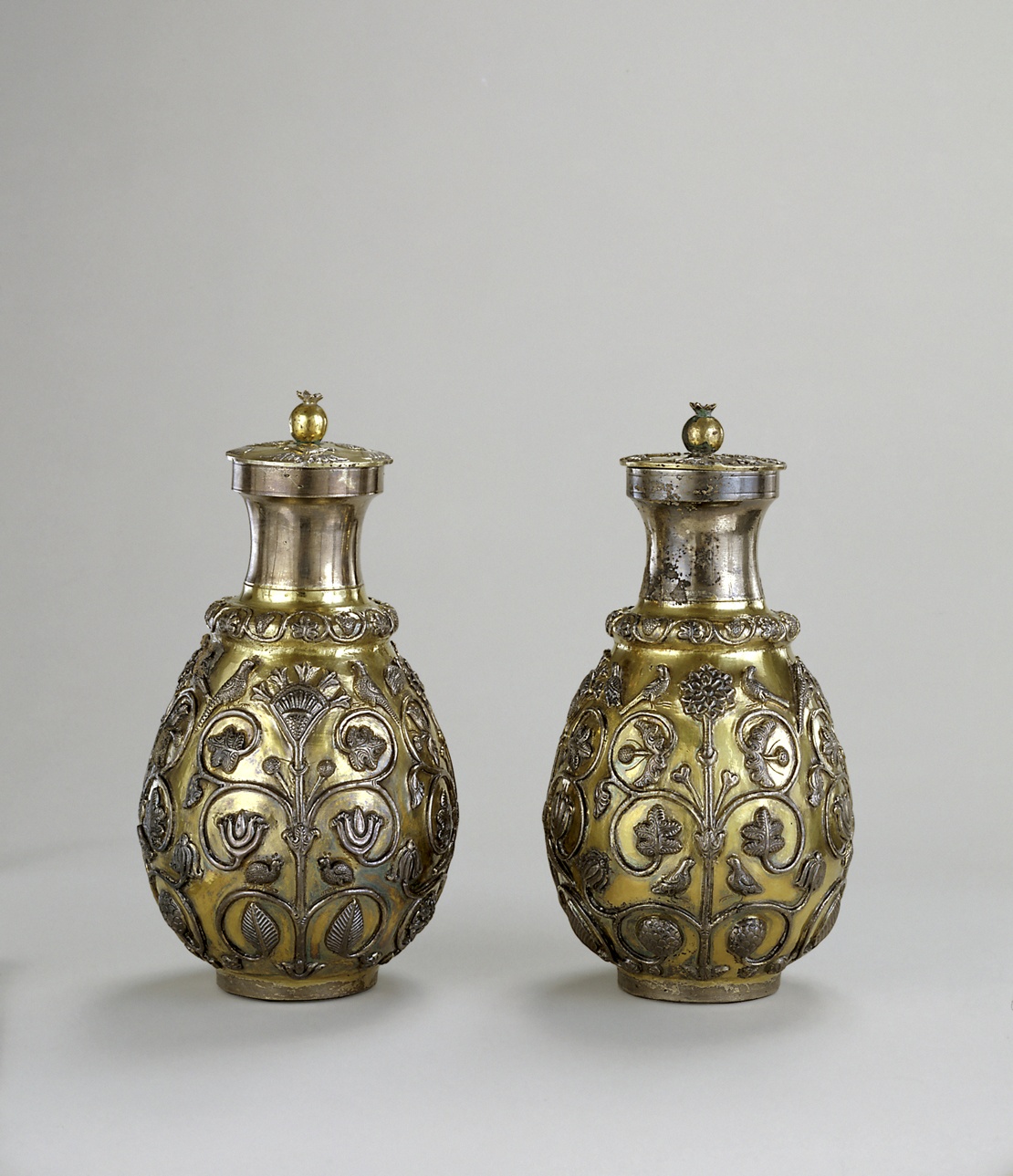
Silver gilt
Weight: a. 475.03 g (526.83 g with lid); b. 527.23 g. H: a. 16.46 cm (18.4 cm with lid); b. 16.7 cm (without modern lid)
Provenance: Iran
Sassanian
5th-7th century A.D. [1]
Ex collection:
Maurice Tempelsman
The body roughly formed from a silver sheet cut into a disc and hammered into an approximate shape, excess silver cut off at the rim. For detailed analysis of the general technique see cat. no. 152. Repeatedly worked alternately repoussé from the inside and chased from the outside. The foot made separately and annealed on; on a., an inscription punched underneath. Extensively worked and chiselled in the cold; the gilding applied by the mercury technique; the gilded parts carefully burnished both to strengthen their adherence and for visual effect; the silver neck and rim burnished and polished. The lid made up of three parts: a hammered metal disc with the motifs chiselled in, but in relief as the rest of the surface is hammered back; its underside with a circular strip - hammered, cut, joined and soldered onto it - enabling insertion into the neck of the vessel; the knob made by hammering and cutting with a tang inserted through a hole in the lid and flattened underneath. Gilding, burnishing and polishing as for body.
Condition: a. vessel cleaned but traces of limestone deposit on neck, mouth and under foot, also some oxidized silver under foot. The gilding on the lid's knob, a pomegranate, three fifths covered with a green cuprous chloride, an emanation from the silver's copper content, its calyx slightly worn. b. vessel also cleaned but with limestone deposit on two of the birds, in a few other places and on rim of mouth. Missing, the lid, the present cover a modern replacement.
Vessel a. is the one on the right side of the plate.
These vessels for wine are unusual for being a true pair and most exceptionally one of them still has its original lid [2] surmounted with a pomegranate. One of the jars has an inscription on its underside, which unfortunately has not yet proved decipherable [3]. The shape is common, and many examples are to be found in American museums and private collections acquired over the past forty years [4]. The floral motifs would indicate an early date, probably in the 5th century. However lovely the decorative effect, the floral decoration with the addition of the little birds must have had a symbolic meaning, which unfortunately escapes us.
1 Melikian-Chirvani, A.S.: Argenterie et le bronze iranien, 7e.-11e. siècle. Chapter 2 (doctoral dissertation unpublished). A.S. Melikian-Chirvani in an oral communication told us that he believes the date to be 7th-8th century A.D.
2 All these vessels probably had lids, but this appears to be the only surviving one.
3 A.S. Melikian-Chirvani brilliantly photographed it in the author's house but unfortunately the two Pahlavi specialists he entrusted it to for reading eventually declared that they could make nothing of it.
4 E.g. von Bothmer, D. (ed.): Glories of the Past. Ancient Art from the Shelby White and Leon Levy Collection (New York, 1990), nos. 44, 45, pp. 60-62 (T.S. Kawami); Gunter, A.C., Jett, P.: Ancient Iranian Metalwork in the Arthur M. Sackler Gallery and the Freer Gallery of Art (Washington, 1992), nos. 33, 34, pp. 188-193.